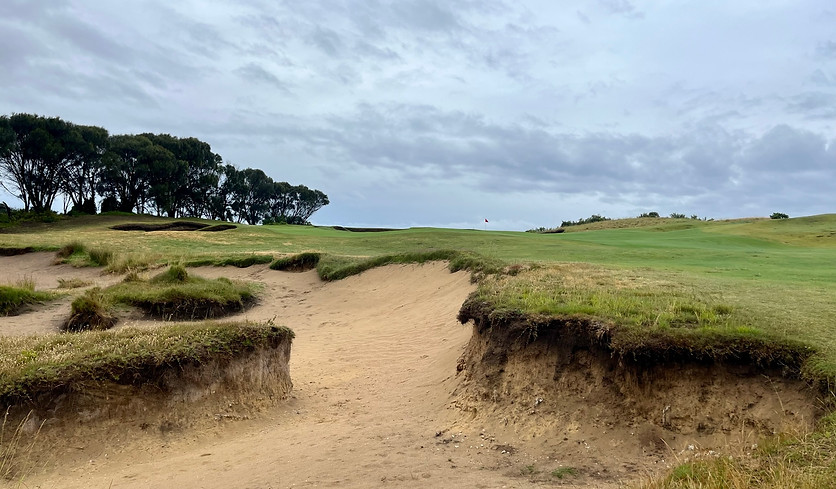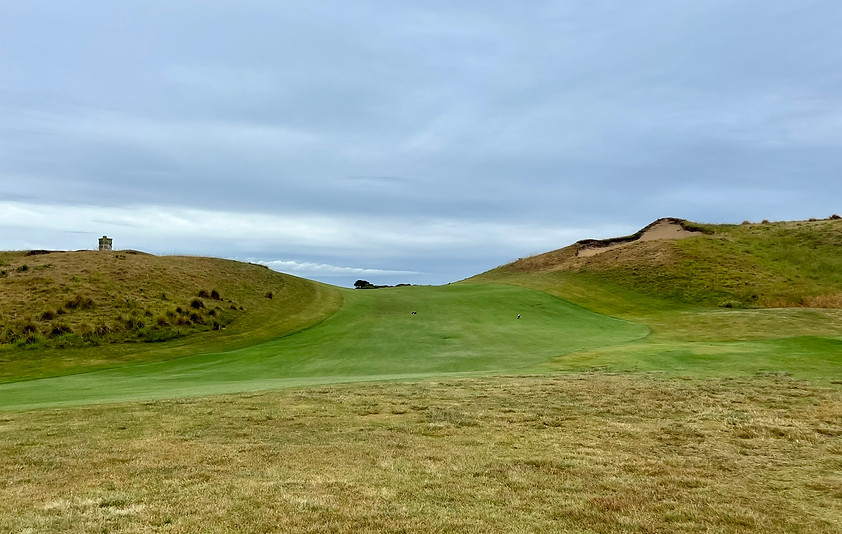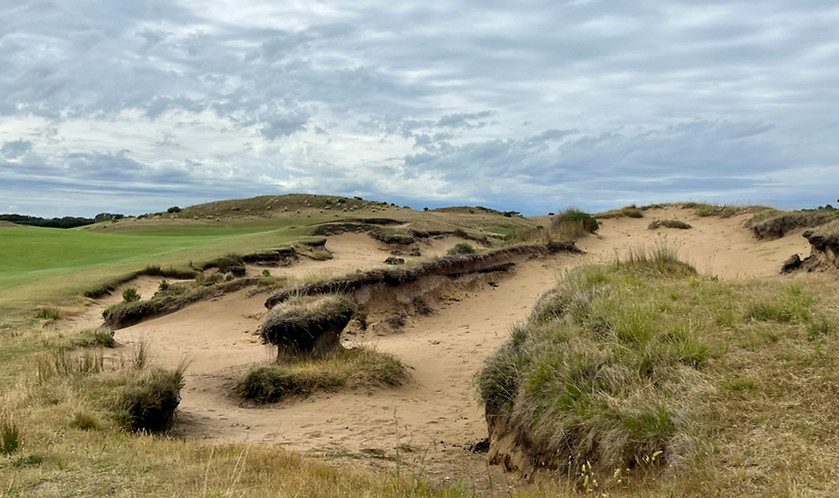
LIII: The Dunes Golf Links
Mainland Australia boasts 36,000 kilometres of gorgeous coastline - around double that of Great Britain, making its relative shortage of links golf all the more remarkable. The Mornington Peninsula however, with its heaving dunes and rolling sandy turf, is a corner of a country dominated by ever-so-slightly inland golf where the character and spirit of the links runs amuck, randomness and joy at the forefront. With its scattering of blind shots across firm rumpled fairways and an eclectic assortment of choppy landforms, to my mind The Dunes is on a short list of Australian layouts which captures the essence of the British links.

Links with an Australian twist
Visually however, there can be no mistaking The Dunes for its Northern Hemisphere counterparts, as the grand expanses and rolling hills of the Mornington Peninsula’s ‘Cups Country’ form a distinctly Australian backdrop and deliver an unmistakable sense of place. Hulking dunes flow through the property with thick ribbons of fairway riding their curves, straddling their ridges and slipping between them – The Dunes boasts a truly remarkable canvas for golf and one can only imagine the sheer excitement of architect Tony Cashmore upon first laying eyes on the sprawling site.
The Dunes’ most striking characteristic lies in its scale – every feature is big, brawny and striking. At times it’s overwhelming as players wander the property dwarfed by sandhills, soaking in the glorious sense of isolation which golfers flee to far flung corners of the globe to experience. There are expansive swathes of short grass which tip, tilt and funnel– not mind-numbing aimless width, but the kind that fashions targets within fairways for the better player, whilst promoting thrilling recoveries and playability. These wide, convoluted and bouncy fairways are the elixir for enjoyment at The Dunes, whilst its hazards are exactly that – an eclectic array of the game’s most striking sandy pits litter the property. Rugged edged and beautifully windswept, they sit effortlessly on the land, as wild and natural as the landforms they divide.

Big dunes & broad slopes
Variety is one of the hallmarks of great golf architecture and at The Dunes, Cashmore staked out a zig-zagging routing through the sandhills of exhilarating diversity. Remarkably, as a result of the chopping and changing, only once in the routing are back-to-back holes played in the same direction, so when the wind blows (as it so often does) golfers find themselves constantly off balance.
Tee shots soar over ridges and dive through valleys; convoluted fairways make flat lies hard to come by and approaches climb steeply to hilltop surfaces and bound with randomness to those sunken below the fairway. Half-par holes are balanced in their direction, yet arrive unexpectedly with bruising two-shotters broken up by birdie opportunities, each presenting a fresh outlook and a different problem to solve.

A distinctly natural form of golf
The Second
After a bruiser of an opening assignment, the second offers little respite. From an elevated tee, the fairway dives into a valley before rising steeply and leftward to an elevated surface. Sprawling waste and bunkering dominates the left side, carving shape to a hole best attacked from near the hazards.

The eroded hazards of the second
The Third
Short holes of immense quality are hardly a scarce resource in Victorian golf, though one would be hard pressed to find one similar to the handsome flick of the third. Playing along the top of a ridgeline at one of the property’s highest points, it’s 140 metres lies raw and exposed. Trademark bunkering guards a crafty double-tiered surface, the dune to the left best used as a kicker, funnelling the ball toward a left pin.

Staggered hazards crowd the second fairway
The Sixth
The Dunes’ variety of holes is best condensed in their variety of one-shotters. Following the perilous flick at the third, the sixth asks a different question entirely – can the golfer flight a ball down and chase it on the ground to the surface. Sharply downhill, 200 metres of short grass tips and tumbles to an enormously rippled sunken green site – with half the flagstick obscured by a fronting ridge, it finds a distinctly Scottish feel. With an endless number of ways to get the ball down, many will find themselves stymied by options – a problem of proper golf.

The simple rolls of the sixth
The Seventh
The charming uncertainty and exhilarating wonder of striking a shot over a dune and into the unknown is undoubtedly one of the most alluring traits of the traditional links. The seventh tee stares directly into the heart of a pair of mighty sandhills, a saddle of short grass the only guiding light. Beyond the dunes, a well struck tee shot reveals a winding fairway through the dunes which paves the way to one of the most intricate greens on the course akin to a rippled crisp.

A tee ball straight out of Britain
The Tenth
One of Cashmore’s great achievements at The Dunes is the glorious assortment of natural greensites which he staked out. Wide-reaching, diverse and glued to the land with grace, the green complexes and surrounds are the heartbeat of the routing. Few approaches are more endearing than the downhill tenth with its green shaved at the base of a looming dune, closing out a sharp dogleg left. Visually majestic and with an array of ways to attack, the 10th condenses many of The Dunes’ best qualities into a single moment.

The classy 10th green site
The Twelfth
Par fives are rarely the most memorable holes in a routing, however most two-shotters aren’t the twelfth at The Dunes. Though the tee shot is fairly straightforward, the second is dominated by the rugged wasteland which smothers the right corner of the dogleg. Injecting an element of risk-reward, reaching the green in two requires a long carry across the hazard to the green below – a thrilling moment in the loop.

The great hazard smothering the right corner
The Fifteenth
A minority tee ball which asks a linear question – can you split the two hazards flanking the fairway? The 15th fairway is majestic as it tips and rumbles, a whirlpool of slopes bounding balls every which way – the spirit of the links runs rampant. In an amphitheatre of dunes, the semi-punchbowl green gathers balls off the left hillside. A two-shotter of immense quality.

A proper test of links golf
Across a rollicking site, The Dunes delivers engaging golf hole after hole in a range of different ways. Cashmore has tied together an excellent criss-crossing routing with an exceptionally diverse and compelling set of greens – a layer of intricacy that many of the traditional links don’t have. Pairing The Dunes with St Andrew’s Beach a couple of miles down the road makes for one of the most architecturally dynamic publicly-accessible weekends in golf and shouldn’t be overlooked on a trip to the revered Sandbelt. The Dunes punches well beyond its miserly green fee, and for that, Australian golfers are better off.